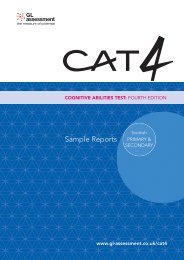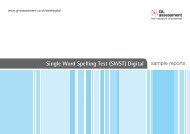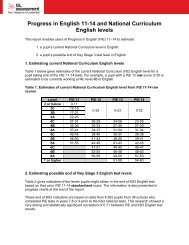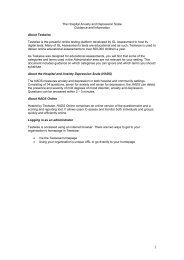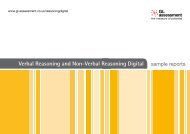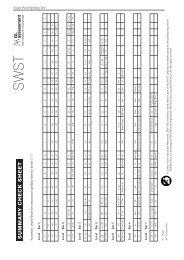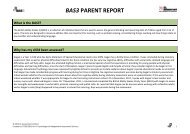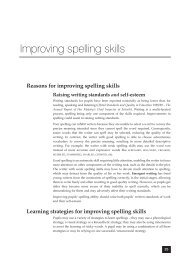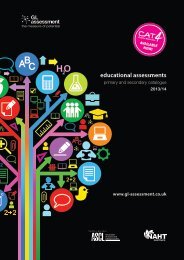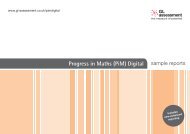DIAGNOSTIC TEST OF WORD READING PROCESSES
diagnostic test of word reading processes - GL Assessment
diagnostic test of word reading processes - GL Assessment
- No tags were found...
Create successful ePaper yourself
Turn your PDF publications into a flip-book with our unique Google optimized e-Paper software.
Diagnostic Test of Word Reading Processes<br />
However, reading soon becomes a major source of oral vocabulary development, and so<br />
pupils start to come across written words whose meanings and pronunciations are not<br />
already in their oral vocabulary. In these cases, developing lexical-semantic processes<br />
involves:<br />
• storing knowledge of the letter sequence of the written word<br />
• inferring something of the word’s meaning from the context in which it occurs<br />
• working out a pronunciation for the word from its letter sequence<br />
• linking the letter sequence to the word’s meaning and pronunciation.<br />
And, of course, unfamiliar words encountered in print may well be mispronounced: for<br />
example, ‘misled’ may become ‘mizzled’, and give rise to a new verb ‘to mizzle’ (as<br />
evidenced in the speech error ‘don’t mizzle me’).<br />
Once the letter sequence of a previously unknown written word has been stored and<br />
linked to its meaning and pronunciation, on subsequent encounters that written word<br />
will be recognised immediately on sight. Instant recognition leads to automatic and<br />
effortless recovery of the stored meaning and pronunciation. Lexical-semantic processing<br />
is extraordinarily fast and operates without any conscious awareness on the part of the<br />
skilled reader.<br />
Lexical-semantic processes are involved in reading all words, both regular and exception. 4<br />
However, they are uniquely tapped by Exception Word Reading, as Exception Word<br />
Reading is only achieved through lexical-semantic processing. Therefore, Exception Word<br />
Reading is used in this test as the measure of lexical-semantic processes.<br />
Importantly, the sequence of operations in lexical-semantic processing is from stored letter<br />
sequence to word meaning to word pronunciation. Thus, these processes allow us to<br />
distinguish between homophones like ‘sail’ and ‘sale’, even when we read them without<br />
any disambiguating context. The letter sequence ‘sail’ is linked to the meaning ‘an area of<br />
fabric used to catch the wind and propel a boat over water’, whereas the letter sequence<br />
‘sale’ is linked to the meaning ‘the exchange of goods, property or services for an agreed<br />
sum of money or credit’.<br />
8<br />
4<br />
The only requirement is that words should be familiar to the reader. That is, they must have been previously encountered in print<br />
sufficiently often for their letter sequences, meanings and pronunciations to have been stored. In skilled readers, one or two encounters<br />
with a written word are sufficient. For beginner readers, many more encounters are needed: some young beginner readers fail to<br />
recognise and understand written words that they have seen very many times previously (see, for example, Stuart et al., 2000).



